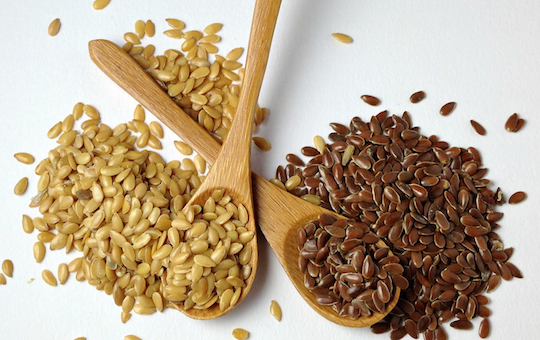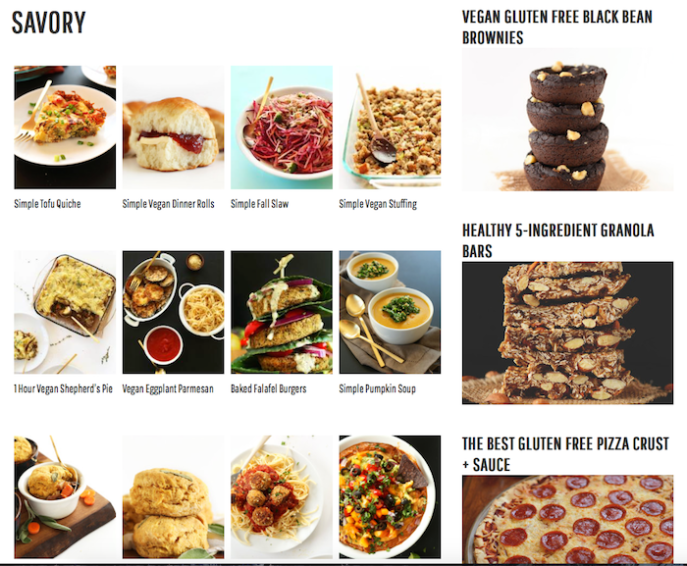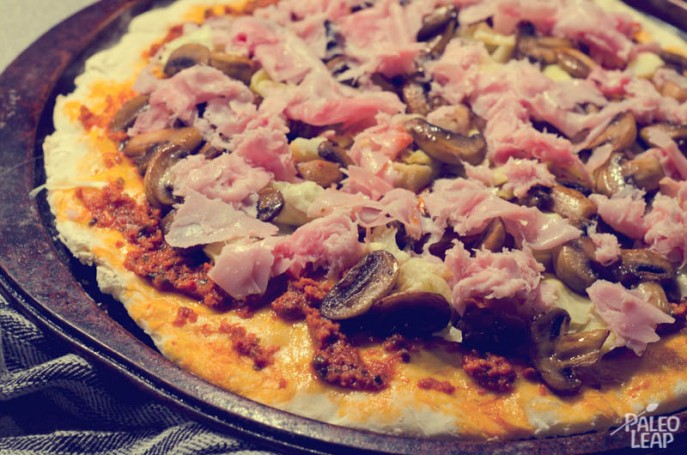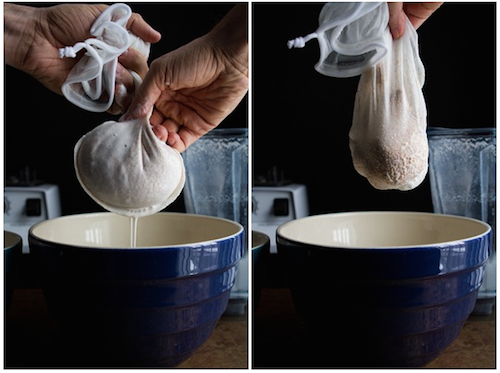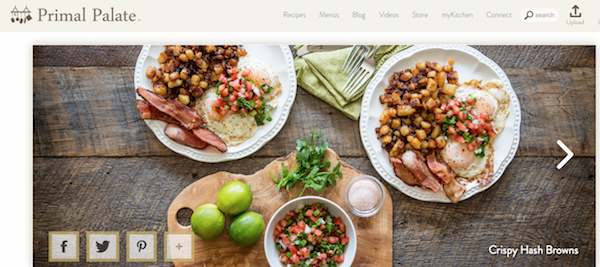First, flax is a great source of fiber. Most Americans do not get enough fiber in their diet. Each tablespoon of flax contains about 8 grams of fiber. This helps keep the bowels regular. Because of all the fiber, be sure to start slow (say, with a half-teaspoon) and build up. Otherwise, you may experience bloating.
Second, flax is a plant source of omega-3. Once again, most Americans are short on their omega-3 fatty acids. These essential fatty acids (“essential” meaning they must be consumed because our bodies don’t make them) play an important role in the anti-inflammatory system of our body. Flax contains the shorter chain omega-3 called ALA (alpha-linolenic acid). Thus, it is not a replacement for fish or fish oil supplements that contain DHA (docosahexaenoic acid) and EPA (ecosapentaenoic acid.)
Third, flax contains lignans which reduce the risk of breast cancer in women and prostate cancer in men. The lignans alter the way your body metabolizes estrogens into safer forms.
As if this wasn’t enough, flax has been shown to reduce hot flashes in menopausal women. To reap the benefits, this requires a daily dose of 2 tablespoons. And flax can normalize the menstrual cycle by supporting the second phase (the luteal phase).
Safety: Other than the bloating that may occur in a new user, flax is very safe. It’s a food that has been with us for thousands of years.
How to: Start slow and build up. Remember to grind it. (It is useful to get a coffee grinder for this purpose. Preground flax spoils, or oxidizes, quickly. Unground, the impermeable coating may make it pass right through you, and you won’t absorb any of the benefits.) Add it to cooked oatmeal, to pancake batter, or to yogurt. It has a nice nutty flavor. Don’t buy the oil as that eliminates the fiber and most of the lignans.
http://www.doctoroz.com/blog/victoria-maizes-md/benefits-flax
A rich source of healing compounds, flaxseed (also called linseed) has been cultivated for more than 7000 years. First cultivated in Europe, the plant’s brown seeds were regularly used to prepare balms for inflamed skin and healing slurries for constipation. Rich in essential fatty acids, or EFAs, flaxseed oil is used to prevent and treat heart disease and to relieve a variety of inflammatory disorders and hormone-related problems, including infertility.
The essential fatty acids (Omega oils)in flaxseed oil are one of its key healing components. EFAs are particularly valuable because the body needs them to function properly, but can’t manufacture them on its own. Essential fatty acids work throughout the body to protect cell membranes, keeping them efficient at admitting healthy substances while barring damaging ones.
One of the EFAs in flaxseed oil, alpha-linolenic acid, is known as an omega-3 fatty acid. Like the omega-3s found in fish, it appears to reduce the risk of heart disease and numerous other ailments.
Flaxseed oil is an excellent source of omega-3s: Just 1 teaspoon contains about 2.5 grams, equivalent to more than twice the amount most people get through their diets. Flaxseeds also contain omega-6 fatty acids in the form of linoleic acid; omega-6s are the same healthy fats found in vegetable oils.
Flaxseed oil only contains these alpha-linolenic acid (Omega 3 oils), and not the fiber or lignan components that the whole plant contains. Therefore, flaxseed oil provides the Omega 3 benefits, such as lipid-lowering properties, but not the laxative or anti-cancer properties.
Whole flaxseeds (not the extracted oil) are a rich source of lignans (phytoestrogens), substances that appear to positively affect hormone-related problems. Lignans may also be useful in preventing certain cancers and combating specific bacteria, fungi, and viruses, including those that cause cold sores and shingles.
Flaxseed may help to:
Lower cholesterol, protect against heart disease and control high blood pressure:
Several studies indicate that flaxseed oil, as well as ground flaxseeds, can lower cholesterol, thereby significantly reducing the risk of heart disease. Taking flaxseed oil may also protect against angina (chest pain) and high blood pressure. In addition, a five-year study done recently at Boston’s Simmons College found that flaxseed oil may be useful in preventing a second heart attack. It may also help prevent elevated blood pressure by inhibiting inflammatory reactions that cause artery-hardening plaque and poor circulation.
Counter inflammation associated with gout, lupus and fibrocystic breasts:
Omega-3 fatty acids appear to limit the inflammatory reaction associated with these conditions. In cases of lupus, flaxseed oil not only reduces inflammation in the joints, skin and kidneys, but also lowers cholesterol levels that may be elevated by the disease. Taking flaxseed oil for gout may lessen the often sudden and severe joint pain or swelling that is a symptom of this condition. In addition, the ability of omega-3 fatty acids to boost the absorption of iodine (a mineral often found in low levels in women suffering from fibrocystic breasts) makes flaxseed oil potentially valuable for treating this often painful condition.
Control constipation, hemorrhoids, diverticular disorders and gallstones:
As they are high in dietary fibre, ground flaxseeds can help ease the passage of stools and thus relieve constipation, hemorrhoids and diverticular disease. In those with diverticular disease, flaxseeds may also keep intestinal pouches free of waste and thus keep potential infection at bay. Taken for inflammatory bowel disease, flaxseed oil can help to calm inflammation and repair any intestinal tract damage. In addition, the oil may prevent painful gallstones from developing and even dissolve existing stones.
Treat acne, eczema, psoriasis, sunburn and rosacea:
The essential fatty acids in flaxseed oil are largely responsible for its skin-healing powers. Red, itchy patches of eczema, psoriasis and rosacea often respond to the EFA’s anti-inflammatory actions and overall skin-soothing properties. Sunburned skin may heal faster when treated with the oil as well. In cases of acne, the EFAs encourage thinning of the oily sebum that clogs pores.
Promote healthy hair and nails:
The abundant omega-3 fatty acids in flaxseed oil have been shown to contribute to healthy hair growth (in fact, low levels of these acids may cause dry and lackluster locks). Hair problems exacerbated by psoriasis or eczema of the scalp may respond to the skin-revitalizing and anti-inflammatory actions of flaxseed oil as well. Similarly, the oil’s EFAs work to nourish dry or brittle nails, stopping them from cracking or splitting.
Minimise nerve damage that causes numbness and tingling as well as other disorders:
The EFAs in flaxseed oil assist in the transmission of nerve impulses, making the oil potentially valuable in treating conditions of numbness and tingling. The oil’s nerve-nourishing actions may also help in the treatment of Parkinson’s disease, a degenerative disorder of the nervous system, and protect against the nerve damage associated with diabetes and multiple sclerosis.
Reduce cancer risk and guard against the effects of ageing:
The lignans in flaxseed appear to play a role in protecting against breast, colon, prostate, and perhaps skin cancer. Although further studies are needed, research undertaken at the University of Toronto indicates that women with breast cancer, regardless of the degree of cancer invasiveness, may benefit from treatment with flaxseed. Interestingly, the lignans may protect against various effects of ageing as well.
Treat menopausal symptoms, menstrual cramps, female infertility and endometriosis:
Because the hormone-balancing lignans and plant estrogens (phytoestrogens) in flaxseed help stabilise a woman’s estrogen-progesterone ratio, they can have beneficial effects on the menstrual cycle, and relieve the hot flashes of perimenopause and menopause. Flaxseed may also improve uterine function and thus treat fertility problems. In addition, the essential fatty acids in flaxseed have been shown to block production of prostaglandins, hormone like substances that, when released in excess amounts during menstruation, can cause the heavy bleeding associated with endometriosis.
Fight prostate problems, male infertility and impotence:
The EFAs in flaxseed oil may help to prevent swelling and inflammation of the prostate, the small gland located below the bladder in males that tends to enlarge with age. Symptoms of such enlargement, such as urgency to urinate, may lessen as a result. The EFAs also play a role in keeping sperm healthy, which may be of value in treating male infertility, and they can improve blood flow to the penis, a boon for those suffering from impotence.

